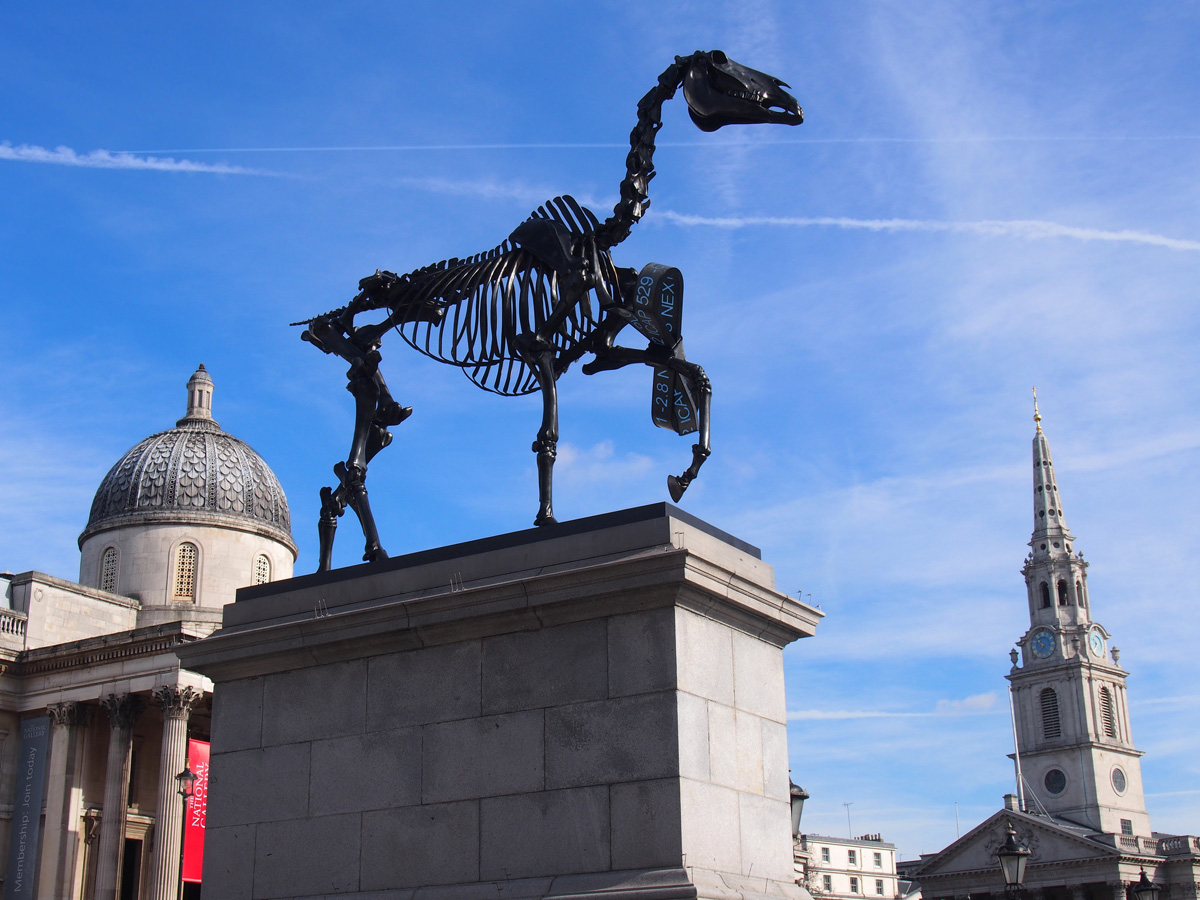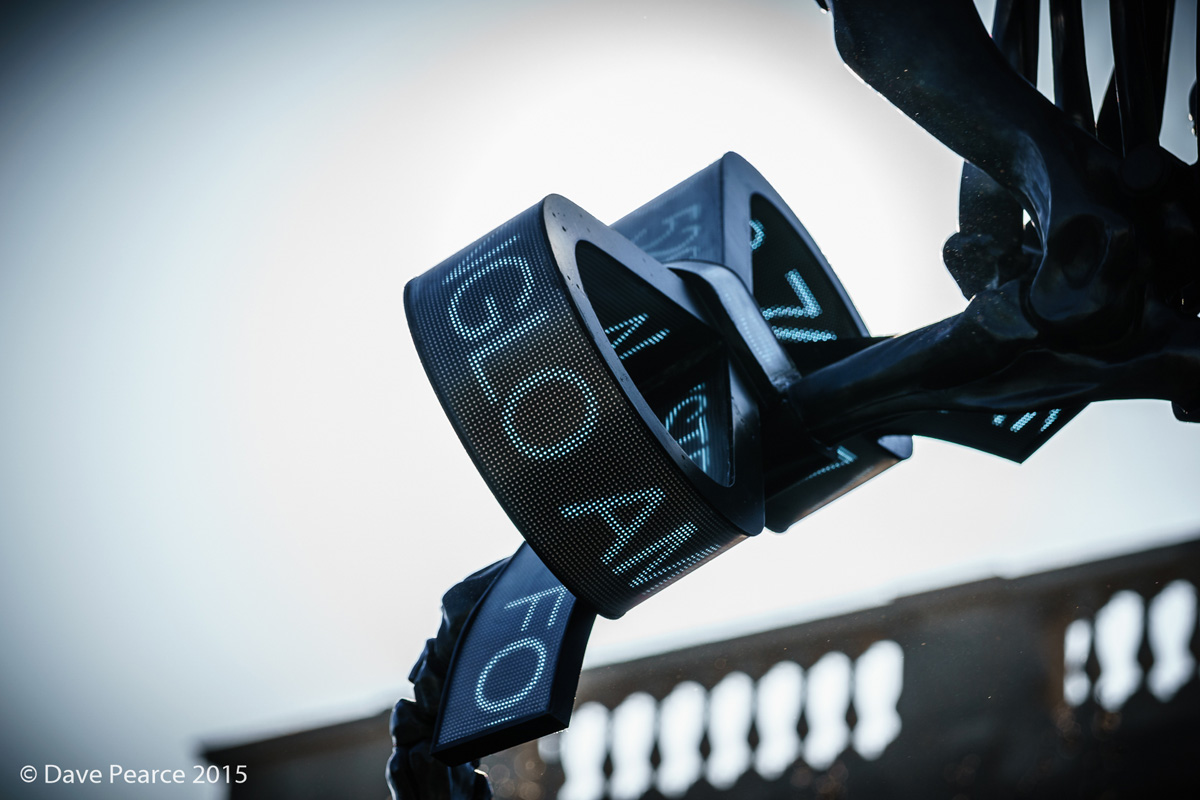The tenth sculpture to occupy the long-vacant fourth plinth in Trafalgar Square is Hans Haacke’s Gift Horse.

The plinths in the other three corners of the Square have been occupied by their statues from the outset. The one in the north-east corner supports a statue of George IV on horseback. The north-western one, built in 1841 for a statue of William IV on horseback, remained empty as the project ran out of money. It remained empty until 1999 when the Royal Society of Arts’ Fourth Plinth Project commenced with Mark Wallinger’s sculpture Ecce Homo. It was followed by Bill Woodrow’s Regardless of History in 2000 and Rachel Whiteread’s Monument in 2001, and then the plinth was empty once more. In 2005, the Mayor of London set up the Fourth Plinth Commission to enable this wonderfully successful series of temporary exhibits to continue.
Hack’s Gift Horse was unveiled on 5 March 2015, following Katharina Fritsch’s very popular Hahn/Cock. Gift Horse is a twice-life-size skeleton of a horse in a dark gunmetal bronze, partly based on engravings by the eighteenth-century artist George Stubbs.
Haacke says,
[The] more I thought and learned about the space, including the fact that an equestrian statue was originally meant to be on the plinth . . . I wanted to do something with a horse. But to really speak about what is going on these days it had to be a skeleton and so I started to do some research. . . . I knew Stubbs from the Tate gallery and other places, but I didn’t know he had dissected horses and made these engravings. That was a great revelation. And, of course, he is in the National Gallery with the painting Whistlejacket, and the work began to come together.
It has strong thematic ties, therefore, with the original purpose of the plinth. On its front leg, however, is a bow, as if on a present. It’s a digital display showing live prices from the London Stock Exchange, which Haacke is using as an oblique reference to Adam Smith's <em>The Wealth of Nations</em>, upon which free-market capitalism is largely based.

Gift Horse reflects the symbols of power which surround it, combines them with a potent symbol of free market capitalism, and places them in the context of death. Haacke, always a very political artist, says,
Some 250 years [after Adam Smith], followers of Smith’s ‘mythical hand’ [the invisible hand of the market] flock to the City of London, to Wall Street and other market places around the world, while the less fortunate look to the bare bones of the horseplay of today’s gentry.
Haacke comments that he was 'absolutely flabbergasted' that his proposal was accepted, and says ‘There is no way that something that plays with Wall Street in this fashion would ever be approved under the auspices of the mayor [of New York]’.
However, Mayor of London Boris Johnson took a very different line on Gift Horse in his speech:
There will be those who say that this undeniably underfed beast . . . is a symbol of the excessive pursuit of austerity and the George-Osborne-diet approach to life. But I say absolutely not. . . . In those fabulous tubular structures you will see symbolised the vital infrastructure – the tube that must run beneath the surface of any great and beautiful city. The tubular structures that have received such fantastic investment thanks to our chancellor . . . and indeed playing a part in the greatest economic recovery this city has ever seen, and the driving force of the UK and indeed [the] European economy.
This was such a contrary view to how most people see Gift Horse that Adrian Searle, writing in The Guardian, described Johnson's speech as 'vulgar and somewhat dismissive'. Maybe it is (though Johnson knew that he was being contrarian and earned a good laugh for doing so) but good art is always open to more than one interpretation because it presents us with images for us to reflect on, rather than telling us what to think.
Art with such an expressly political edge thus functions very much like the vivid imagery used by the Old Testament prophets. Isaiah, for example, said,
Your whole head is injured,
your whole heart afflicted.
From the sole of your foot to the top of your head
there is no soundness –
only wounds and welts and open sores,
not cleansed or bandaged or soothed with olive oil.
(Isaiah 1:5–,6 NIV)
Isaiah uses the graphic image of a person who is in a bad state physically to prompt his listeners to reflect on their bad spiritual state. Many of his hearers may well have gone away without ever stopping to reflect on his deeper meaning, in the same way that many who see Gift Horse may not stop to to reflect on what Hans Haacke is saying. But both the artist and the prophet want us to stop and think more deeply about ourselves and the world in which we live.